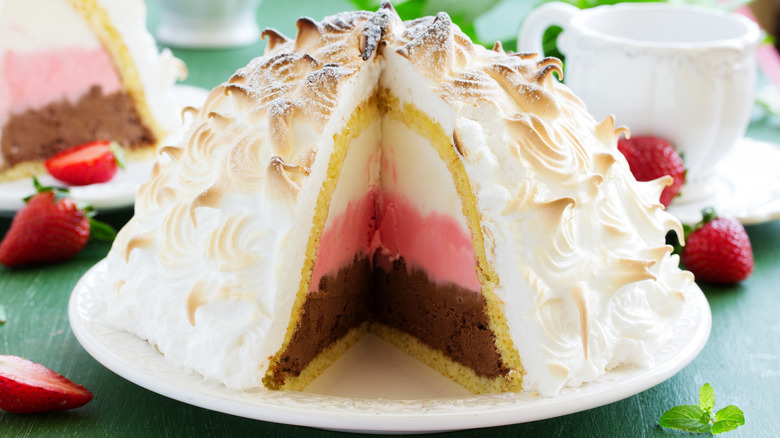Why Doesn't Baked Alaska Melt When It's Set On Fire?
Baked Alaska is essentially an ice cream cake that looks like a snowy mound when viewed intact from the outside. But unlike most snowy mounds, this one is embellished with caramelized peaks thanks to a quick broil in the oven or being set on fire with a kitchen torch. Its name, which may have originated at the iconic Delmonico's restaurant, is meant to honor the 49th state admitted to the Union.
Baked Alaska begins with a thin bottom layer of cake — sometimes sponge, but not necessarily, followed by layers of well-packed ice cream or sorbet. When you cut open a baked Alaska, it looks like a trifle, except there's ice cream where the custard or pudding would be. Moreover, Baked Alaska is surrounded by a thick meringue coating instead of being encased in glass.
In some versions of this retro dessert, such as the one shown above, the cake surrounds the frozen mound, thereby lining the ice cream and meringue. However, this layer is optional because a properly assembled Baked Alaska will hold its shape even when exposed to the high heat of the oven/broiler or kitchen torch. So how does this layered dessert not melt into a puddle when set afire? Spoiler alert: It all comes down to the meringue.
How meringue works its magic in Baked Alaska
Although Baked Alaska was named after a U.S. territory and the eventual state that was purchased by the U.S. from Russia in 1867, its roots go back to the early 1800s. That was when the American-born scientist and inventor Sir Benjamin Thompson, aka Count Rumford, is believed to have discovered that meringue works as an effective insulator from heat. According to Scientific American, air in the form of air pockets is actually quite effective at deflecting heat — and luckily for Baked Alaska, meringue is the result of whipping air pockets into egg whites.
Count Rumford, who died in 1814 long before the U.S. acquired Alaska, was not a chef and is not credited with inventing the Baked Alaska dessert, nor even its European-born predecessor, the Omelette Norwegge. However, his discovery of meringue's heat-insulating properties is widely believed to have led to the invention of this showy dessert. Indeed, meringue is "why the Baked Alaska works," according to Libby O'Connell, an author and chief historian for the History Channel (via NPR).

